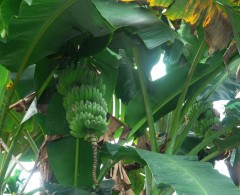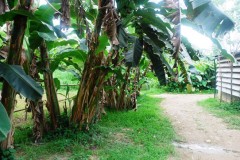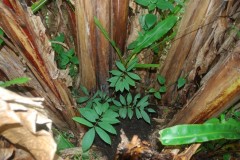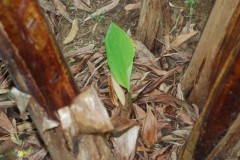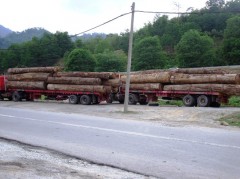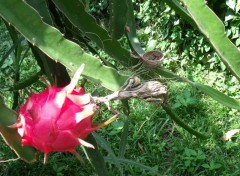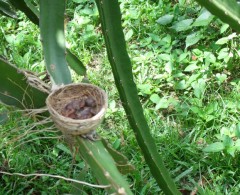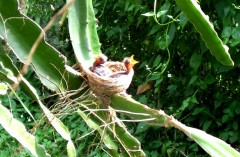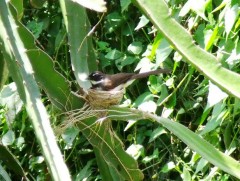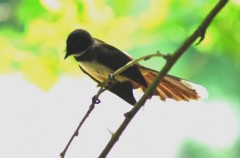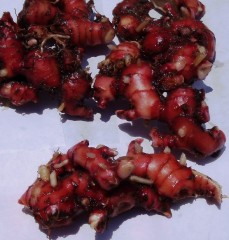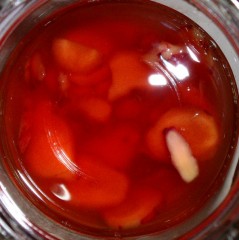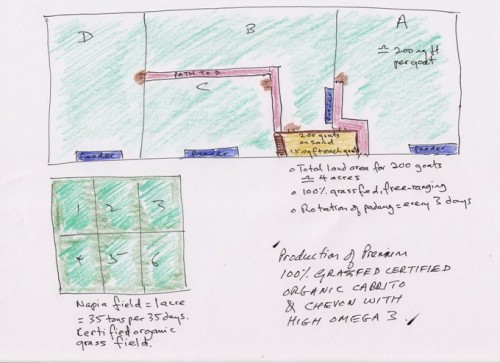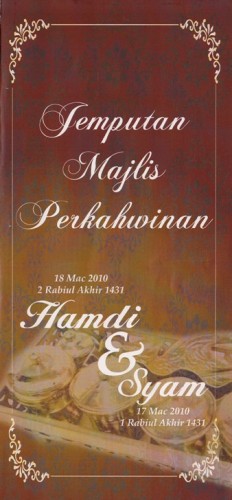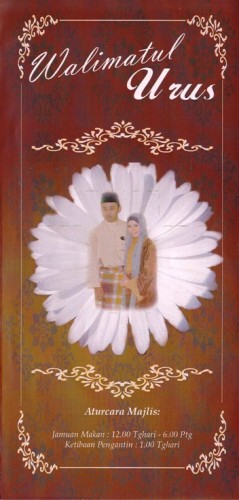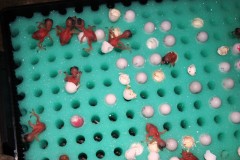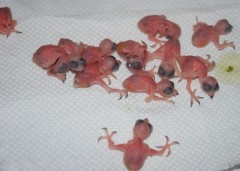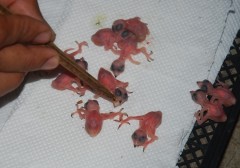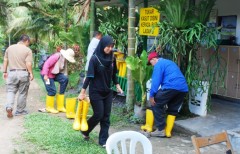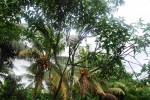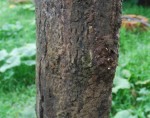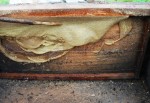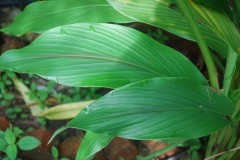Apr 26, 2010
Permaculture is Bananas
Banana plants (it's a giant herb) can make their own food, retain water, and in our farm continuously produce 20 to 40 kg bunches without significant input.
Banana plants at our farm. Producing fruits year after year in the same spot without replanting.
Nowadays farmers grow rows and rows of tissue-cultured clones. These require high fertiliser and fungicide inputs.
At our farm, the banana epitomises permanent agriculture. We use our human intelligence to plant them at the right place - they like moisture and organic material. They will form a clump - trim the clump to about 4 to 5 plants so that they will produce reasonable sized bunches
A banana clump serves as a heat absorber. They cool down the earth due to their ability to retain water and reduce radiation of heat to buildings due to their shady leaves.
The centre of the clump hosts myriad microbes and earthworms due to its dark and moist conditions rich in organic matter. They quickly break down fallen leaves, dead trunks, etc into humus and then release these nutrients back to the clump as food. We only need to occasionally supplement with some compost and some chopped dead trunks.
We plant tuba or derris elliptica in the centre. The clump provides all the nutrients that the derris require. We don't even need to water the derris.
Derris in the clump :).
We have found that gingers do well in the clumps too. Gingers love organic matter and moisture. We are now planting ginger in all the clumps in the farm as a cash crop.
This temu kunci is growing at a faster rate than others planted outside the clump.
We, humans, have a choice - clear the land, plant rows and rows of clones and hybrids, feed them with synthetic nitrogen-based fertilisers and spray them with fungicides and due to the low contribution margin for such crops, go for 'volume', ie clear up more land to generate this 'volume';
Or go the permaculture way - use nature intelligently and work with nature to produce food for us for generations. We may not be rich in the short term, but we will be around for a far longer time. Multiple this idea by 100,000 farms and the landscape of the Earth's future changes!
16:44 Posted in Permaculture | Permalink | Comments (4) | Tags: permaculture, bananas, raised beds, compost, derris elliiptica, temu kunci, boesenbergia rotunda
Apr 23, 2010
Logging - Who Benefits? Part III
Today's Star:
One Citizen, One Tree:
http://thestar.com.my/news/story.asp?file=/2010/4/23/nati...
Council to plant a tree for every child born in Perak
http://thestar.com.my/news/story.asp?file=/2010/4/23/nati...
And lovely Sabah, home to Maliau, and what's left of the Orang Utan race:
http://thestar.com.my/news/story.asp?file=/2010/4/23/nation/6113557&sec=nation
Today Near The Farm:
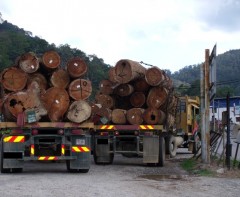
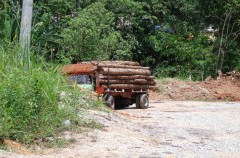
Malaysians, please take note we are paying for all these tree planting. They are not for free.
Someone is cutting down 50 to 100 year old trees, clearing huge tracts of CO2 absorbing forests, destroying huge water catchment areas and laughing all the way to the bank. You know who these people are! (If you don't, FIND OUT!)
And we end up paying to plant trees, to pay for water pipelines from distant places, to pay for higher water rates, to pay for storms and flash floods, to pay for cooling as our cities become hotter. It is just not right.
This is what you can do for Earth Day:
Start by knowing who these tree cutters are! Here's a partial list.
And when they donate money for schools, reject their donation.
When they contribute to local houses of worship, return their money.
When they come with an entourage to open some park or building, or to plant a tree (yes, they have!) show your back to them.
When they give a lecture as a public figure or an opinion leader if you like, please throw your slippers at them! :)
Malaysians get your values right! These are not people to be emulated or honoured or respected.
10:51 Posted in Blog | Permalink | Comments (0) | Tags: logging, timber
Apr 13, 2010
Organic Farming - Oasis For Birds
An organic farm is like an oasis to birds. At our farm we have counted close to 50 species. Foreign workers at our farm comment that there's no longer any necessity to keep them in cages as they are all around us and we don't even have to feed or water them! That's a valuable lesson they will take back with them after they finish their contract with us.
And the birds lost most of their fear for humans. They will nest anywhere; next to the kitchen, on pillars, inside a comb of bananas, or like the photos here, on a dragon fruit plant in broad daylight in plain view of passer-bys and vehicles :
Right next to a ripened dragon fruit.
A couple of hatchlings in a meticulously weaved cup with tidy, even rim.
The bird that made this cup is the Pied Fantail or Rhipidura Javanica Longicauda.
In our farm, they have grown used to being in close proximity to humans, but remain wild as nobody in the farm is allowed to feed the birds.
The Pied Fantail is distinguished from other Fantails by pale underparts with a contrasting blackish breast-band.
When annoyed, it gives a chit, cheet sound to distract you from its nest.
It lays a clutch of 2 eggs and is common throughout South East Asia.
Mum's back.
Close up (click on picture) of the Pied Fantail. Note the breast-band, and the barely noticeable white eye-brow.
Here's why they are named Fantail (click on pic for close-up).
18:04 Posted in Blog | Permalink | Comments (0) | Tags: organic farming, sustainable agriculture, birding
Apr 11, 2010
Useful Plants At The Farm - Red Ginger
Red Ginger (zingiber officinale var rubrum) has a sharper taste and is more aromatic than normal ginger. Though cultivated, it can also be found growing wild in the jungles.
If you are a lover of the taste and aroma of ginger in cooking, then the red ginger is something you must try.
Here's red ginger in apple cider vinegar. The red color seeps into the vinegar and is preserved by the acid. Fresh red ginger exposed to light will fade within hours.
The red ginger has excellent anti-inflammatory properties and is especially effective for those with chronic inflammatory problems such as arthritis, carpal tunnel, etc. Drinking just a finger on alternate days will do wonders for your aches and pains. Here's a study: http://www.ncbi.nlm.nih.gov/pubmed/20136450
At the farm it is part of a very important tonic which we feed to the chickens when they are doing poorly. The ginger also has strong anti-bacterial activity.
The red ginger is very effective in bringing down high blood pressure. Take two thumbs, blend with some sugar and then heat it up to just below boiling point for a minute or two. Sieve, and then sip slowly like a tea. Relax, after an hour measure your BP. You will be surprised!
Note that to 'cure' HBP, a holistic approach must be taken. We are not advocating red ginger as a 'cure' for HBP. It should be part of a total approach and you should consult your health-care provider before embarking on any alternative medical treatment.
16:59 Posted in Useful Plants | Permalink | Comments (0) | Tags: ginger, zingiber, halia bara, halia merah, zingiber officinale var rubrum, red ginger;
Mar 25, 2010
Caviar of the East - Pavlovian Imprinting
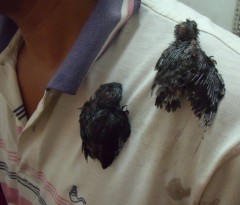
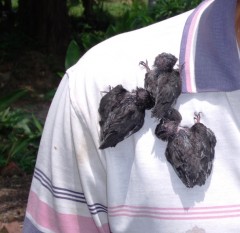
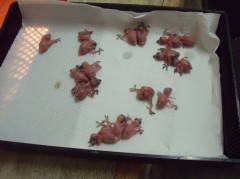
09:39 Posted in Blog | Permalink | Comments (1) | Tags: swiftlet farming, walit, walet, swiftlets, aerodramus fuciphagus, aerodramus maximus
Mar 20, 2010
Grassfed Cabrito
18:21 Posted in Goats | Permalink | Comments (0) | Tags: organic cabrito, chevon, grassfed goat, free-ranging goat, mutton
Mar 19, 2010
Thank You Encik Mukthar
11:43 Posted in Blog | Permalink | Comments (0) | Tags: malay weddings
Feb 26, 2010
Caviar of the East - Building the Population
Building up the critical mass naturally takes time. We decided to speed things up a little by incubating eggs and acclimatising them to the micro-climate at our farm from hatchlings.

Hatching out in a mere 16 days, not 20 + days as recorded in most books. Almost failed as knowing the incubation period is critical to a successful hatch. However daily observation and experience permitted us to have a successful hatch inspite of misinformation from books and various blogs (one blog recommended an incubation temperature of 40 celcius. That will most likely 'cook' the embryo).
In the brooder at 35 celcius.
Hand feeding starts 8 hours after hatching.
Update:
Feathering after 14 days
Feathering after 21 days
16:12 Posted in Blog | Permalink | Comments (5) | Tags: swiftlet farming, walit, walet, swiftlets, aerodramus fuciphagus, aerodramus maximus
Jan 29, 2010
Captain (Rtd) Zaman aka Eudrillus and Mardi Officers came visiting
Captain (Rtd) Zaman aka Eudrillus made a surprise visit with some officers from Mardi.
Captain Zaman with the crew-cut seeping coconut water and Zul and others from Mardi.
Captain Zaman asked about the keyhole raised beds. Well, here they are and they keep on expanding....
And what is organic fruit farming without weaver ants or kerangga. Here, they are used to get rid of termites infesting a tree.
And our latest project, designing a proper home for stingless bees of which now, we have discovered, we have four species in the farm.
Temporary home. The bees made this sail-like canvas to protect themselves from ants.
This is the design we are working on now as a permanent home for the bees; design from Utrecht University, Tobago.
10:50 Posted in Visitors | Permalink | Comments (1) | Tags: captain zaman, eudrillus, mardi
Jan 10, 2010
Useful Plants At The Farm- Curcuma Mangga
Curcuma mangga is also known as white turmeric. It tastes like a mango, hence the name 'mangga'.
The rhizome with skin and without.
Researchers have found anti-tumour activities from extracts of the rhizomes. On a personal basis, we have found it to have strong anti-inflammatory effect and we have incorporated it into our diet on a regular basis, either as a ulam or salad, or as a drink.
The plant can reach about 5 feet high.
Close up of the leaf
At the farm, we gather the soil around the roots and rhizome and make a foliar spray to combat fungal infections on plants.
Take one part soil, one part molasses, and 4 parts water and aerate vigorously for 10 hours.
Use twice a week on plants with signs of fungal attacks.
19:35 Posted in Useful Plants | Permalink | Comments (11) | Tags: temu pauh, kunyit putih, curcuma mangga, actinomycetes, anti fungal, anti tumour








